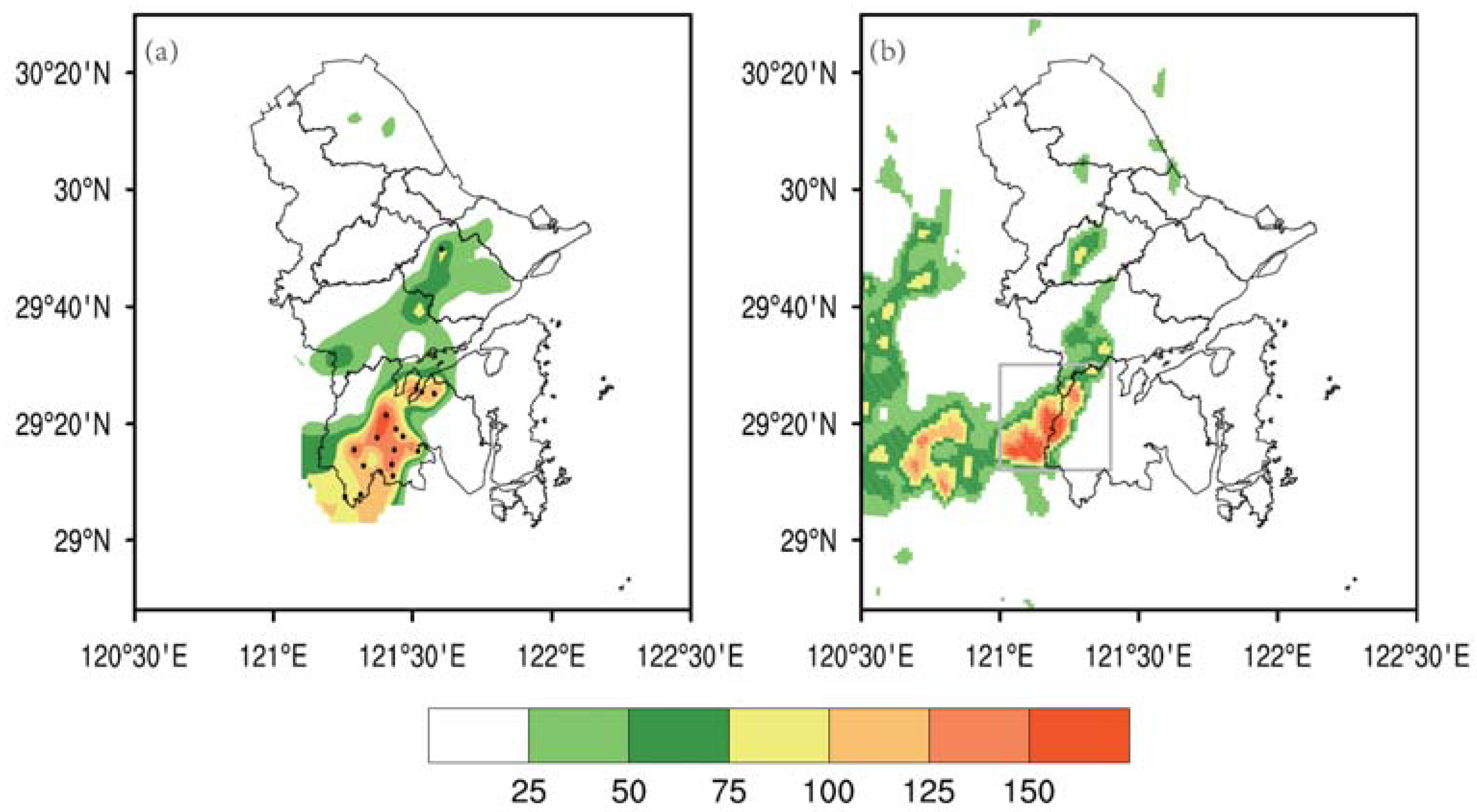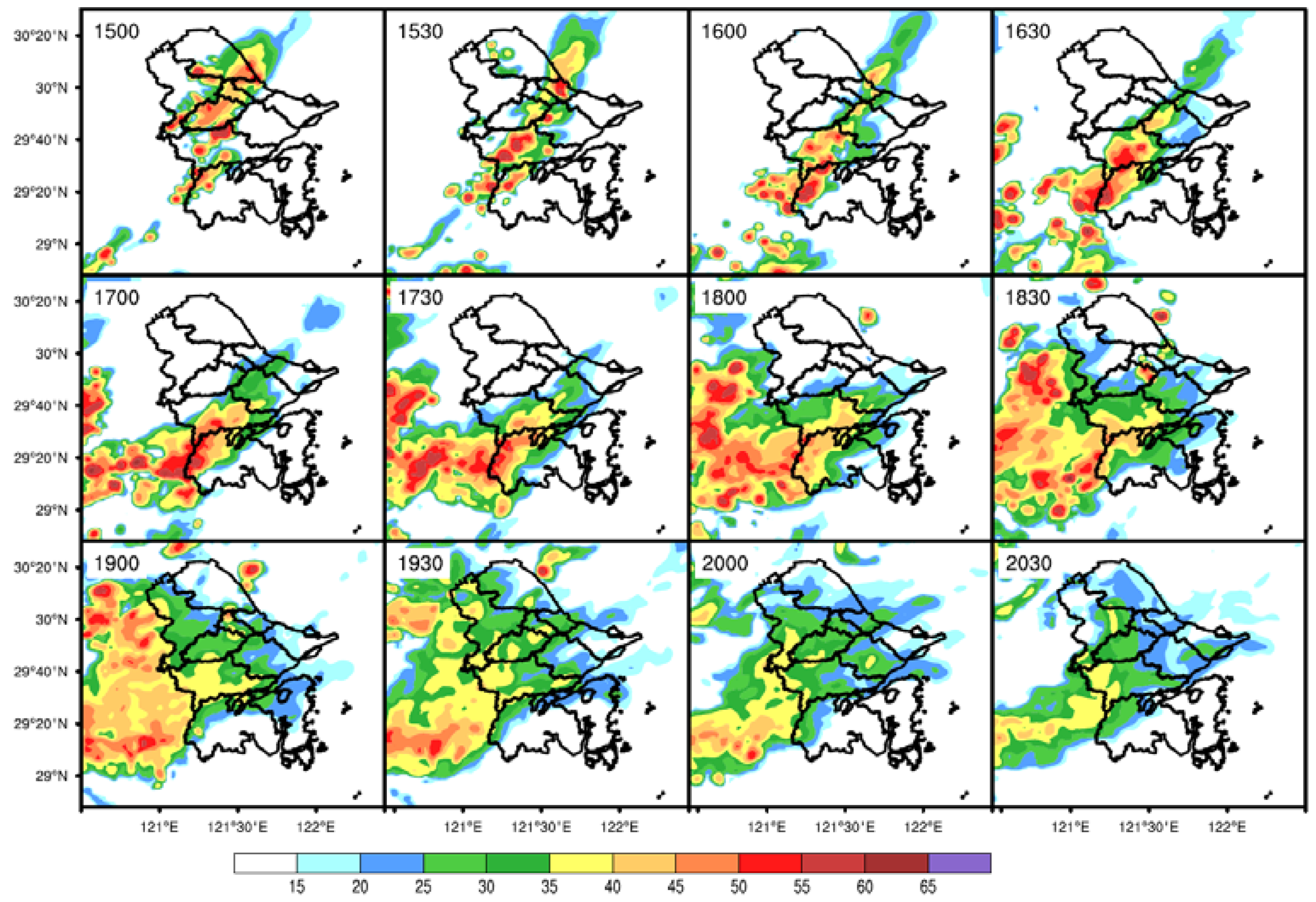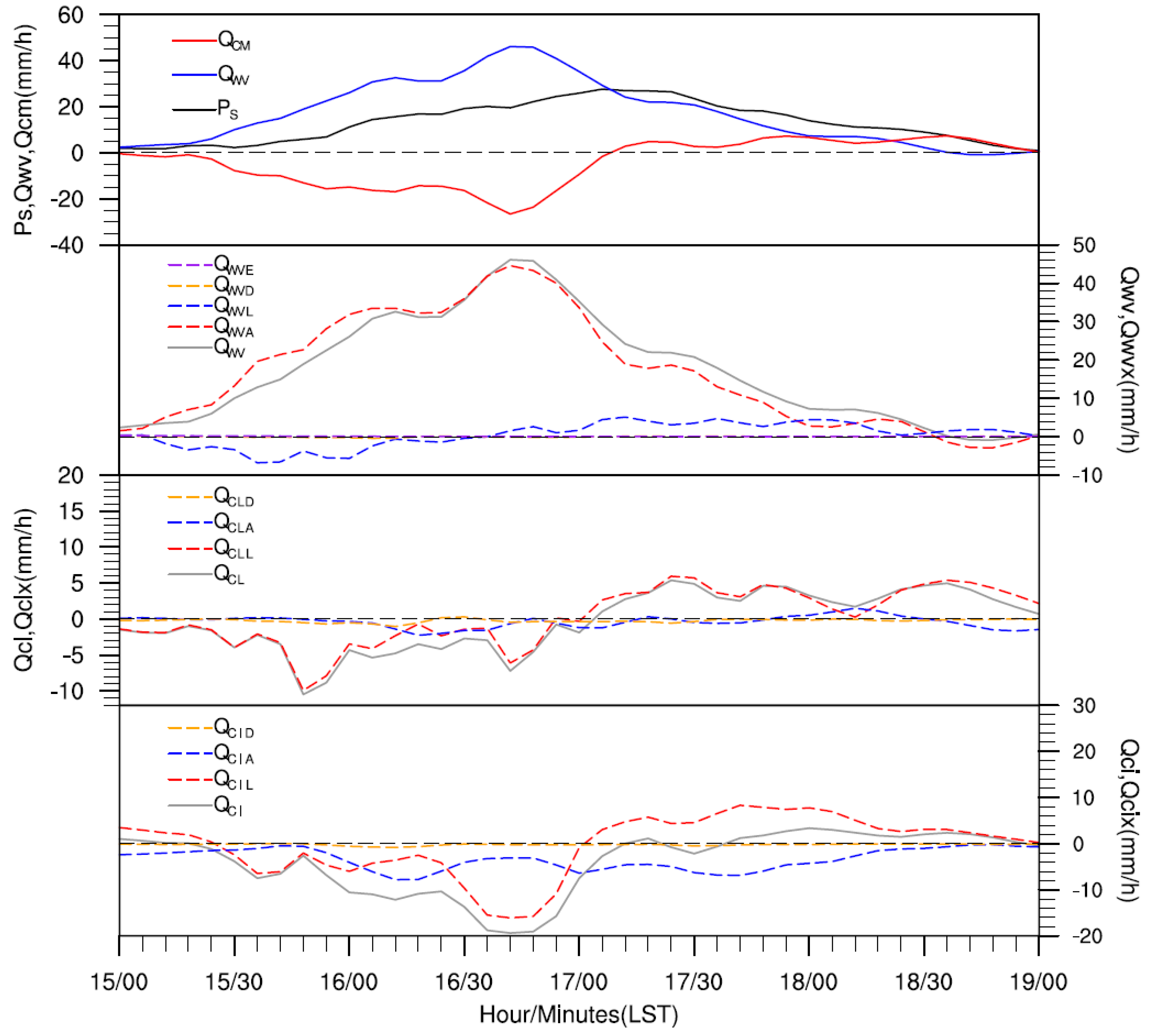Simulation and Diagnosis of Physical Precipitation Process of Local Severe Convective Rainstorm in Ningbo
Abstract
:1. Introduction
2. Materials and Methods
2.1. Data
2.2. Mode Scheme
2.3. Three-Dimensional Precipitation Diagnostic Equation
3. Results
3.1. Local Severe Convective Rainstorm Process on 31 July 2021
3.2. Simulation Verification
3.2.1. Verification of Circulation Characteristics and Evolution Simulation
3.2.2. Radar Reflectivity Characteristics and Evolution Simulation Verification
3.2.3. Simulation and Verification of Hourly Rainfall Evolution
3.3. Diagnosis of Precipitation Physical Processes
4. Conclusions
- (1)
- The precipitation event on 31 July in Ningbo was initiated and intensified locally, catalyzed by favorable large-scale quasi-geostrophic dynamics alongside specific regional conditions. These included the eastward movement of the 500 hPa trough and the 850 hPa shear line, as well as potentially influential outflows from the cold pool of the local convective system. The validation of the simulation across various parameters—such as high- and low-altitude circulation patterns, combined radar reflectivity, and hourly precipitation rates—indicates a commendable alignment with observational data. Despite some discrepancies in finer details, the model adeptly captured the primary characteristics and progression of major atmospheric circulations and weather systems. The simulated radar echo’s structure and evolution closely mirrored actual observations, with the onset of heavy rainfall matching real-world timings. Additionally, the model accurately represented the spatial distribution of intense rainfall, its developmental phases, and the duration, aligning well with recorded events.
- (2)
- Before reaching the peak of precipitation intensity, the notable convergence of water vapor flux (QWVA) plays a dual role: facilitating precipitation formation and augmenting local atmospheric humidity. As the precipitation event progresses, the intensity of QWVA diminishes significantly, leading to a scenario where the convergence of water vapor no longer suffices to sustain the observed precipitation intensity, thus markedly reducing the moisture content in the local atmosphere. The dynamics of liquid-phase water condensates are predominantly influenced by local variances (QCLL), underscoring the pivotal role of cloud microphysical processes throughout the precipitation cycle. Furthermore, the budget of ice-phase water condensate is not only governed by local variances (QCIL) but also significantly by the processes of convergence/divergence (QCIA). The consistent negativity of QCIA suggests that the augmentation in ice-phase water condensate primarily stems from the conversion of liquid-phase water condensate. Concurrently, strong upward movements push the ice-phase water condensate towards the upper troposphere, from which it diffuses outward, illustrating the complex interactions that characterize the precipitation process.
- (3)
- During the main precipitation phase of the convective system’s development, both the intensity and the extent of vertical uplift notably intensify, culminating at the precipitation peak before gradually diminishing. Initially, in the primary phase, the modest peak of vertical uplift is situated near a height of approximately 4 km below the zero-degree isotherm, subsequently strengthening and expanding to reach a zenith of 12 km. However, in the later stages of this phase, the descent of raindrops introduces a negative center of vertical motion below the zero-degree level, positioned around 4 km. This dynamic vertical movement significantly influences the concentration of water condensates, although the extent of these changes varies. Notably, the augmentation of graupel particles and raindrops is most marked, attaining their highest concentration at the precipitation’s peak, followed by a gradual decline. The pronounced fluctuations in raindrop levels are intricately linked to variations in surface precipitation intensity (Ps), whereas the dynamics of graupel particles are primarily associated with the melting processes occurring beneath the zero-degree layer. While shifts in cloud water and snow are observed, these alterations are considerably less dramatic than those observed in raindrops and graupel particles.
Author Contributions
Funding
Institutional Review Board Statement
Informed Consent Statement
Data Availability Statement
Acknowledgments
Conflicts of Interest
References
- Tao, S. Rainstorms in China; Science Press: Beijing, China, 1980; 225p. [Google Scholar]
- Xu, F.; Xu, X.; Cui, X.; Zhang, G. Torrential rainfall responses to radiation and ice clouds over Jiang–Huai valley, China in July 2007. Asia-Pac. J. Atmos. Sci. 2013, 49, 401–407. [Google Scholar] [CrossRef]
- Gao, S.; Tan, Z.; Zhao, S.; Luo, Z.; Lu, H.; Wang, D.; Cui, C.; Cui, X.; Sun, J. Mesoscale dynamics and its application in torrential rainfall systems in China. Adv. Atmos. Sci. 2015, 32, 192–205. [Google Scholar] [CrossRef]
- Wu, G.; Cai, Y.; Tang, X. Moist potential vorticity and slantwise vorticity development. Acta Meteorol. Sin. 1995, 53, 387–405. [Google Scholar]
- Cui, X.; Gao, S.; Wu, G. Up-sliding Slantwise Vorticity Development and the complete vorticity equation with mass forcing. Adv. Atmos. Sci. 2003, 20, 825–836. [Google Scholar] [CrossRef]
- Luo, Y.; Sun, J.; Li, Y.; Xia, R.; Du, Y.; Yang, S.; Zhang, Y.; Chen, J.; Dai, K.; Shen, X.; et al. Science and prediction of heavy rainfall over China: Research progress since the reform and opening-up of the People’s Republic of China. Acta Meteorol. Sin. 2020, 78, 419–450. [Google Scholar] [CrossRef]
- Li, Q.; Cui, X.; Cao, J. Observational analysis and numerical simulation of a heavy rainfall event in Sichuan Province. Chin. J. Atmos. Sci. 2014, 38, 1095–1108. [Google Scholar] [CrossRef]
- Huang, Y.; Cui, X. Moisture sources of an extreme precipitation event in Sichuan, China, based on the Lagrangian method. Atmos. Sci. Lett. 2015, 16, 177–183. [Google Scholar] [CrossRef]
- Li, H.; Cui, X.; Zhang, D. A statistical analysis of hourly heavy rainfall events over the Beijing metropolitan region during the warm seasons of 2007–2014. Int. J. Climatol. 2017, 37, 4027–4042. [Google Scholar] [CrossRef]
- Zhai, G.Q.; Li, X.F.; Zhu, P.J.; Shen, H.; Zhang, Y. Surface Rainfall and Cloud Budgets Associated with Mei-yu Torrential Rainfall over Eastern China during June 2011. Adv. Atmos. Sci. 2014, 31, 1435–1444. [Google Scholar] [CrossRef]
- Zhang, Y.; Meng, Z.Y.; Zhu, P.J.; Su, T.; Zhai, G. Mesoscale Modeling Study of Severe Convection over Complex Terrain. Adv. Atmos. Sci. 2016, 33, 1259–1270. [Google Scholar] [CrossRef]
- Song, X.; Zhang, J.; AghaKouchak, A.; Roy, S.S.; Xuan, Y.; Wang, G.; He, R.; Wang, X.; Liu, C. Rapid urbanization and changes in spatiotemporal characteristics of precipitation in Beijing metropolitan area. J. Geophys. Res. Atmos. 2014, 119, 11250–11271. [Google Scholar] [CrossRef]
- Wu, M.; Luo, Y.; Chen, F.; Wong, W.K. Observed link of extreme hourly precipitation changes to urbanization over coastal South China. J. Appl. Meteorol. Climatol. 2019, 58, 1799–1819. [Google Scholar] [CrossRef]
- Jiang, X.; Luo, Y.; Zhang, D.; Wu, M. Urbanization enhanced summertime extreme hourly precipitation over the Yangtze River delta. J. Clim. 2020, 33, 5809–5826. [Google Scholar] [CrossRef]
- Lenderink, G.; van Meijgaard, E. Increase in hourly precipitation extremes beyond expectation-ns from temperature changes. Nat. Geosci. 2008, 1, 511–514. [Google Scholar] [CrossRef]
- Pendergrass, A.; Knutti, R. The uneven nature of daily precipitation and its change. Geophys. Res. Lett. 2018, 45, 11980–11988. [Google Scholar] [CrossRef]
- Zhang, J.; Shen, J.; Jiang, L. Analysis on large-scale circulation characteristics of meiyu rainstorm and structure of meiyu front in Zhejiang province during 2008. Plateau Meteorol. 2009, 28, 1075–1084. [Google Scholar]
- Huang, Z.; Han, L.; Jin, R.; Huang, C. Analysis of characteristics and causes of typhoon rainstorms in Tianmu mountain area of Zhejiang. Meteorol. Sci. Technol. 2022, 50, 10. [Google Scholar] [CrossRef]
- Shen, X.; Pan, L.; Zuo, J.; Sang, M.; Zhang, L. Comparative analysis on two similar falling area rainstorms during Meiyu period in western Zhejiang province. J. Arid Meteorol. 2022, 40, 244–255. [Google Scholar] [CrossRef]
- Ma, C.; Li, Y.; Xu, B. Impact of Double Low-Level Jets on the Extreme Rainstormin Henan Province in July 2021. Chin. J. Atmos. Sci. 2023, 47, 1611–1625. (In Chinese) [Google Scholar] [CrossRef]
- Huang, Y.; Cui, X.; Li, X. A three-dimensional WRF-based precipitation equation and its application in the analysis of roles of surface evaporation in a torrential rainfall event. Atmos. Res. 2016, 169, 54–64. [Google Scholar] [CrossRef]
- Lu, T.; Cui, X. Simulation and Diagnosis of the Physical Process of the “7·20” Heavy Rainfall in Beijing in 2016. Chin. J. Atmos. Sci. 2022, 46, 359–379. (In Chinese) [Google Scholar] [CrossRef]
- Liu, S.; Cui, X. Diagnostic Analysis of Rate and Efficiency of Torrential Rainfall Associated with Bilis (2006). Chin. J. Atmos. Sci. 2018, 42, 192–208. [Google Scholar] [CrossRef]
- Wang, X.; Cui, X.; Hao, S. Diagnostic and Numerical Study on Surface Rainfall Processes Associated with Tropical Cyclone Soudelor (2015) over the Ocean. Chin. J. Atmos. Sci. 2019, 43, 417–436. [Google Scholar] [CrossRef]
- Wang, X.; Cui, X.; Hao, S. A Diagnostic and Numerical Study on Surface Rainfall Process of Tropical Cyclone Soudelor (2015) over the Ocean: Sensitivity Experiments on Precipitation Response to Sea Surface Temperature Change. Chin. J. Atmos. Sci. 2019, 43, 1125–1142. [Google Scholar] [CrossRef]
- Wang, Y.; Huang, Y.; Cui, X. Surface rainfall processes during the genesis period of tropical cyclone durian (2001). Adv. Atmos. Sci. 2019, 36, 451–464. [Google Scholar] [CrossRef]
- Xue, Y.; Cui, X. Diagnostic and Numerical Study on Physical Process of Strong Rainfall Associated with Rammasun (1409). Chin. J. Atmos. Sci. 2020, 44, 1320–1336. (In Chinese) [Google Scholar] [CrossRef]
- ETA-Interim Public Dataset of the ECMWF. 2018. Available online: http://apps.ecmwf.int/datasets/data/interim-full-daily/levtype=sfc/ (accessed on 1 August 2021).
- Final Operational Global Analysis. 2020. Available online: http://rda.ucar.edu/datasets/ds083.2/ (accessed on 1 August 2021).
- Skamarock, W.; Klemp, J.; Dudhia, J.; Gill, D.O.; Barker, D.M.; Duda, M.G.; Huang, X.Y.; Wang, W.; Powers, J.G. A description of the advanced research WRF version 3. NCAR Tech. Note 2008, 475, 113. [Google Scholar]









| No. | Data Type | Spatiotemporal Resolution |
|---|---|---|
| 1 | Observational data from Ningbo’s encrypted automatic stations | 5 min |
| 2 | Doppler Radar Data | 6 min |
| 3 | ERA5 Reanalysis Data | A fine spatial resolution of 0.25 degrees and a temporal resolution of 6 h |
| 4 | FNL Reanalysis Data | A spatial resolution of 1 degree and a temporal resolution of 6 h |
| No. | Mode Options | Parameter Settings |
|---|---|---|
| 1 | Grid spacings | 12 km/4 km/1.33 km |
| 2 | Grid settings | 328 × 331/478 × 478/448 × 469 |
| 3 | Vertical layers | 50 |
| 4 | Projection | Mercator |
| 5 | Short wave radiation scheme | Dudhia |
| 6 | Long wave radiation scheme | RRTM |
| 7 | Boundary layer parameterization scheme | YSU |
| 8 | Cumulus convection parameterization scheme | Kain-Fritsch (only in the outer layer) |
| 9 | Microphysics parameterization scheme | WDM6 |
| 10 | Surface plan | Monin-Obukhov |
| 11 | Land surface parameterization scheme | Noah |
| No. | Terms | Physical Meaning |
|---|---|---|
| 1 | Rain rate | |
| 2 | Vertically integrated negative local change rate of water vapor | |
| 3 | Vertically integrated 3D moisture flux convergence/divergence rate | |
| 4 | Surface evaporation rate | |
| 5 | Vertically integrated 3D moisture diffusion rate | |
| 6 | Vertically integrated negative local change rate of liquid-phase hydrometers | |
| 7 | Vertically integrated 3D flux convergence/divergence rate of liquid-phase hydrometers | |
| 8 | Vertically integrated 3D diffusion rate of liquid-phase hydrometers | |
| 9 | Vertically integrated negative local change rate of ice-phase hydrometers | |
| 10 | Vertically integrated 3D flux convergence/divergence rate of ice-phase hydrometers | |
| 11 | Vertically integrated 3D diffusion rate of ice-phase hydrometers |
Disclaimer/Publisher’s Note: The statements, opinions and data contained in all publications are solely those of the individual author(s) and contributor(s) and not of MDPI and/or the editor(s). MDPI and/or the editor(s) disclaim responsibility for any injury to people or property resulting from any ideas, methods, instructions or products referred to in the content. |
© 2024 by the authors. Licensee MDPI, Basel, Switzerland. This article is an open access article distributed under the terms and conditions of the Creative Commons Attribution (CC BY) license (https://creativecommons.org/licenses/by/4.0/).
Share and Cite
Lu, T.; Ding, Y.; Liu, Z.; Wu, F.; Xue, G.; Zhang, C.; Fu, Y. Simulation and Diagnosis of Physical Precipitation Process of Local Severe Convective Rainstorm in Ningbo. Atmosphere 2024, 15, 658. https://doi.org/10.3390/atmos15060658
Lu T, Ding Y, Liu Z, Wu F, Xue G, Zhang C, Fu Y. Simulation and Diagnosis of Physical Precipitation Process of Local Severe Convective Rainstorm in Ningbo. Atmosphere. 2024; 15(6):658. https://doi.org/10.3390/atmos15060658
Chicago/Turabian StyleLu, Tingting, Yeyi Ding, Zan Liu, Fan Wu, Guoqiang Xue, Chengming Zhang, and Yuan Fu. 2024. "Simulation and Diagnosis of Physical Precipitation Process of Local Severe Convective Rainstorm in Ningbo" Atmosphere 15, no. 6: 658. https://doi.org/10.3390/atmos15060658
APA StyleLu, T., Ding, Y., Liu, Z., Wu, F., Xue, G., Zhang, C., & Fu, Y. (2024). Simulation and Diagnosis of Physical Precipitation Process of Local Severe Convective Rainstorm in Ningbo. Atmosphere, 15(6), 658. https://doi.org/10.3390/atmos15060658






